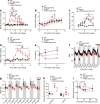Antioxidants protect against diabetes by improving glucose homeostasis in mouse models of inducible insulin resistance and obesity
- PMID: 31309261
- PMCID: PMC6805816
- DOI: 10.1007/s00125-019-4937-7
Antioxidants protect against diabetes by improving glucose homeostasis in mouse models of inducible insulin resistance and obesity
Abstract
Aims/hypothesis: In the context of diabetes, the health benefit of antioxidant treatment has been widely debated. In this study, we investigated the effect of antioxidant treatment during the development of insulin resistance and hyperphagia in obesity and partial lipodystrophy.
Methods: We studied the role of antioxidants in the regulation of insulin resistance using the tamoxifen-inducible fat-specific insulin receptor knockout (iFIRKO) mouse model, which allowed us to analyse the antioxidant's effect in a time-resolved manner. In addition, leptin-deficient ob/ob mice were used as a hyperphagic, chronically obese and diabetic mouse model to validate the beneficial effect of antioxidants on metabolism.
Results: Acute induction of insulin receptor knockout in adipocytes changed the substrate preference to fat before induction of a diabetic phenotype including hyperinsulinaemia and hyperglycaemia. In healthy chow-fed animals as well as in morbidly obese mice, this diabetic phase could be reversed within a few weeks. Furthermore, after the induction of insulin receptor knockout in mature adipocytes, iFIRKO mice were protected from subsequent obesity development through high-fat diet feeding. By genetic tracing we show that the persistent fat mass loss in mice after insulin receptor knockout in adipocytes is not caused by the depletion of adipocytes. Treatment of iFIRKO mice with antioxidants postponed and reduced hyperglycaemia by increasing insulin sensitivity. In ob/ob mice, antioxidants rescued both hyperglycaemia and hyperphagia.
Conclusions/interpretation: We conclude that fat mass reduction through insulin resistance in adipocytes is not reversible. Furthermore, it seems unlikely that adipocytes undergo apoptosis during the process of extreme lipolysis, as a consequence of insulin resistance. Antioxidants have a beneficial health effect not only during the acute phase of diabetes development, but also in a temporary fashion once chronic obesity and diabetes have been established.
Keywords: Acetovanillone; Adipocyte; Adipocyte quantification; Adipocyte-specific; Adipose tissue; Antioxidants; Apocynin; CreERT2; Diet-induced obesity; Fat; Hyperglycaemia; Hyperinsulinaemic–euglycaemic clamp; Hyperphagia; Insulin receptor; Insulin resistance; Leptin deficiency; Lipolysis; N-acetylcysteine; Obesity resistance; Polydipsia obesity; Tamoxifen; Type 2 diabetes; iFIRKO; ob/ob.
Figures




Similar articles
-
Adipocyte integrin-linked kinase plays a key role in the development of diet-induced adipose insulin resistance in male mice.Mol Metab. 2021 Jul;49:101197. doi: 10.1016/j.molmet.2021.101197. Epub 2021 Feb 26. Mol Metab. 2021. PMID: 33647469 Free PMC article.
-
Attenuated secretion of glucose-dependent insulinotropic polypeptide (GIP) does not alleviate hyperphagic obesity and insulin resistance in ob/ob mice.Mol Metab. 2017 Jan 19;6(3):288-294. doi: 10.1016/j.molmet.2017.01.006. eCollection 2017 Mar. Mol Metab. 2017. PMID: 28271035 Free PMC article.
-
Downregulation of STRA6 in adipocytes and adipose stromovascular fraction in obesity and effects of adipocyte-specific STRA6 knockdown in vivo.Mol Cell Biol. 2014 Mar;34(6):1170-86. doi: 10.1128/MCB.01106-13. Epub 2014 Jan 13. Mol Cell Biol. 2014. PMID: 24421389 Free PMC article.
-
Leptin- and leptin receptor-deficient rodent models: relevance for human type 2 diabetes.Curr Diabetes Rev. 2014 Mar;10(2):131-45. doi: 10.2174/1573399810666140508121012. Curr Diabetes Rev. 2014. PMID: 24809394 Free PMC article. Review.
-
The Oikawa-Nagao Mouse: A Polygenic Animal Model for Unraveling the Pathophysiology of Type 2 Diabetes and Obesity.J Nippon Med Sch. 2025;92(1):2-9. doi: 10.1272/jnms.JNMS.2025_92-104. J Nippon Med Sch. 2025. PMID: 40058831 Review.
Cited by
-
LC-Q-TOF-MS Characterization of Polyphenols from White Bayberry Fruit and Its Antidiabetic Effect in KK-Ay Mice.ACS Omega. 2020 Jul 8;5(28):17839-17849. doi: 10.1021/acsomega.0c02759. eCollection 2020 Jul 21. ACS Omega. 2020. PMID: 32715269 Free PMC article.
-
Inhibition of AXL receptor tyrosine kinase enhances brown adipose tissue functionality in mice.Nat Commun. 2023 Jul 13;14(1):4162. doi: 10.1038/s41467-023-39715-8. Nat Commun. 2023. PMID: 37443109 Free PMC article.
-
Update of application of olfactory ensheathing cells and stem cells/exosomes in the treatment of retinal disorders.Stem Cell Res Ther. 2022 Jan 10;13(1):11. doi: 10.1186/s13287-021-02685-z. Stem Cell Res Ther. 2022. PMID: 35012635 Free PMC article. Review.
-
In vivo isotope tracing reveals the versatility of glucose as a brown adipose tissue substrate.Cell Rep. 2021 Jul 27;36(4):109459. doi: 10.1016/j.celrep.2021.109459. Cell Rep. 2021. PMID: 34320357 Free PMC article.
-
Adipocyte CAMK2 deficiency improves obesity-associated glucose intolerance.Mol Metab. 2021 Nov;53:101300. doi: 10.1016/j.molmet.2021.101300. Epub 2021 Jul 22. Mol Metab. 2021. PMID: 34303021 Free PMC article.
References
Publication types
MeSH terms
Substances
LinkOut - more resources
Full Text Sources
Medical
Molecular Biology Databases
Miscellaneous

